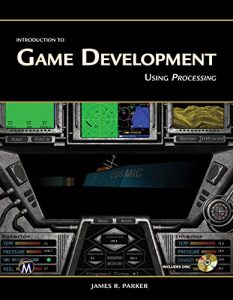This book will guide you through the basic game development process, covering game development topics including graphics, sound, artificial intelligence, animation, game engines, Web-based games, etc. Three real games are created (2D and 3D) as you work through the text, and significant parts of a game engine are built and made available for download. The companion disc contains example code, games, and color figures. [Companion disc files available with Amazon order number and by writing to the publisher at info@merclearning.com]. Processing is a free, graphics-oriented language that provides the basic functionality needed for building games and it runs on all major platforms. Moreover, it allows games to be built for desktop computers, HTML 5, and Android.
Features
+Teaches basic game development concepts including graphics, sound, artificial intelligence, animation, game engines, collision detection, Web-based games, and more
+Includes a companion disc with example code, actual games, and color figures[Companion disc files available with Amazon order number and by writing to the publisher at info@merclearning.com]
+Create three complete computer games developed throughout the book: Hockey Pong, a 2D arcade-style game; SMV Rainbow, a 3D submarine game, and a puzzle game for Android
+ Uses Processing, a free, downloadable platform with a frame by frame display scheme that is perfect for computer games
+Includes a review of game-related mathematics and an introduction to Processing
Brief Table Of Contents
1. Introduction to How Games Work. 2. Graphics and Images in Processing. 3. Sound. 4. Hockey Pong: A 2D Game. 5. Graphics in Three Dimensions. 6. Game AI: Collisions. 7. Navigation and Control. 8. A 3D Game Example. 9. The Web and HTML5 Games. 10. Animation. 11. Android Handheld Devices. Appendix A. Mathematics Tutorial for Games. B. A Processing Primer.
About The Author
J. R. Parker, PhD is a professor of Art Digital Media at the University of Calgary. His areas of research include computer games and media art, computer simulation, and educational technology. Dr. Parker is the author of The Guide to Simulations and Games (Wiley) and Algorithms for Image Processing and Computer Vision, 2/E (Wiley).
Features
+Teaches basic game development concepts including graphics, sound, artificial intelligence, animation, game engines, collision detection, Web-based games, and more
+Includes a companion disc with example code, actual games, and color figures[Companion disc files available with Amazon order number and by writing to the publisher at info@merclearning.com]
+Create three complete computer games developed throughout the book: Hockey Pong, a 2D arcade-style game; SMV Rainbow, a 3D submarine game, and a puzzle game for Android
+ Uses Processing, a free, downloadable platform with a frame by frame display scheme that is perfect for computer games
+Includes a review of game-related mathematics and an introduction to Processing
Brief Table Of Contents
1. Introduction to How Games Work. 2. Graphics and Images in Processing. 3. Sound. 4. Hockey Pong: A 2D Game. 5. Graphics in Three Dimensions. 6. Game AI: Collisions. 7. Navigation and Control. 8. A 3D Game Example. 9. The Web and HTML5 Games. 10. Animation. 11. Android Handheld Devices. Appendix A. Mathematics Tutorial for Games. B. A Processing Primer.
About The Author
J. R. Parker, PhD is a professor of Art Digital Media at the University of Calgary. His areas of research include computer games and media art, computer simulation, and educational technology. Dr. Parker is the author of The Guide to Simulations and Games (Wiley) and Algorithms for Image Processing and Computer Vision, 2/E (Wiley).



